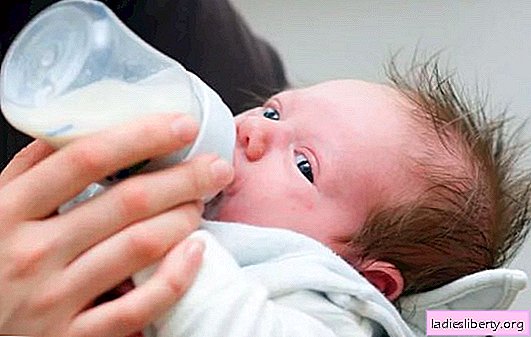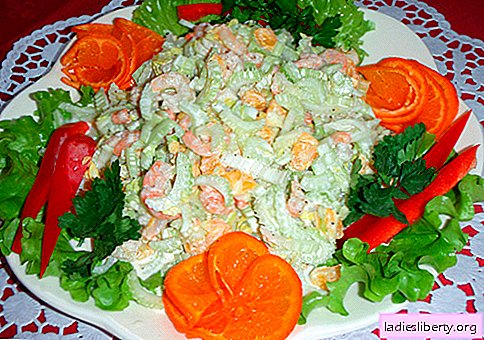
Breasts are considered children from birth to one year of age who are on artificial, breast or mixed feeding.
The first year is the most important period in the life of every child. It was at this time that the rapid growth and development of all vital organs took place.
Proper nutrition of the baby is a guarantee of good health, strong immunity and normal development of the child.
General principles of nutrition of infants
There are several principles for organizing infant nutrition, one of which is on-demand feeding. According to many pediatricians, this is the most optimal option for both mom and child. In the early days, the child can eat about 11-14 times a day, after 1-1.5 months - up to 10-12 times a day. And by half a year the number of meals, as a rule, is reduced to 5-6 times a day.
According to most of the best pediatricians, the first complementary foods should be administered to 4-5 months old babies with artificial feeding, and at 6 months old babies breast-fed. As a first course, mashed vegetables and chicken meat will be an ideal option, after which you can add porridge and mashed fruit to the diet. Starting from 7-8 months, you can give dairy products, for example, kefir or cottage cheese. And, starting from 10 months, fish is introduced into the diet.
Breastfeeding Tips
Of course, breastfeeding is the best way to feed both the baby and the mother. Only with breast milk does the baby receive the maximum amount of nutrients, fatty acids, micro and macro elements. Regular breastfeeding helps to strengthen the baby’s immunity, the normal growth of the baby and the healthy development of all organ systems.
In addition, breastfeeding is the best way to establish a close relationship between mother and baby. It helps to calm, relax and normalize the emotional background.
In order to maximize the benefits of breastfeeding, and the process of natural feeding as long as possible, you should adhere to the following recommendations:
1. It is important to learn how to properly attach the baby to the chest. Otherwise, the baby may develop colic due to air being swallowed with milk, and the mother may develop a crack on her nipples or stagnation of milk in her breast.
2. Do not wash your breasts with soap before each feeding. This will only lead to cracks in the nipples and the destruction of the protective layer of the skin.
3. Do not express breasts if this is not necessary (for example, prolonged absence of the mother). The breast "works" according to the principle, the more milk is gone, the more it has come. Therefore, this can lead to lactostasis in the chest.
4. You should find the most comfortable position for feeding. So that it is convenient for both the mother and the child.
These are the main important points in the organization of breastfeeding. In any difficult situations, you should contact a pediatrician or a specialist in hepatitis B.
Distinctive features of artificial feeding
Very often there are cases when the mother’s milk disappears. For this, special milk formulas for babies have been developed. It should be noted the advantages of artificial feeding:
• the possibility of feeding the baby to other family members in the absence of a mother;
• on IW, the mother can accurately track the amount of the portion that the child ate, while breastfeeding it is difficult to understand whether the baby is full or not;
• it is much easier to identify an allergen on artificial than on breastfeeding;
• Artificial mixtures take longer to digest, which reduces the number of meals.
Despite all the advantages, artificial feeding has several disadvantages:
• the risk of colds and infectious diseases in babies with artificial feeding is much higher than in breastfeeding;
• regular sterilization of bottles and containers is required for preparing mixtures and feeding;
• feeding with mixtures is often accompanied by bloating, colic and increased gas formation;
• preparation of the mixture consists of several stages, which is completely inconvenient on a trip or trip;
• the selection of a suitable mixture for the baby is a rather complicated process;
• financial side of the issue: artificial feeding requires a certain monetary outlay, since mixtures are quite expensive.
After weighing all the advantages and disadvantages of this type of food, you need to choose the type of mixture.
Classification of Artificial Mixtures
Three types of artificial mixtures are distinguished:
1. Adapted mixtures. They are made from cow or goat milk with the addition of demineralized whey. Such mixtures are as close as possible to breast milk, so they are ideal for the first weeks of a baby's life. The most popular adapted mixtures: Semper, Nestle NAN, Nutricia Nutrilon.
2. Partially adapted mixtures. To a lesser extent, they resemble breast milk in structure and composition. They contain not only lactose, but also sucrose, and also do not have a stabilized fat-mineral component. These include: Detolact, Baby, Sun, Vitalact and others.
3. Unadapted mixtures. Their main component is powdered whole cow's milk. The composition also contains starch and sucrose, no whey. This type of artificial mixture is least like mother's milk. Due to the content of casein in its composition, it can cause colic, indigestion, bloating and disturbance of the intestinal microflora.
In addition, the mixture is distinguished by acidity. There are fermented milk mixtures and fresh or sweet. And also emit dry mixtures (instant powder) and liquid, which are extremely rare.
Rules for the preparation of artificial mixtures
For normal digestibility of the milk mixture, you must adhere to the instructions for cooking:
1. To dilute the mixture, you must buy water intended for infants. Boiling ordinary water will lead to the loss of all useful minerals and trace elements.
2. The correct dosage is the key to the health of the baby. Lack of water or too much dry mix can lead to gastrointestinal upsets.
3. The temperature of the water for breeding should not exceed 50 ° C, otherwise all useful sour-milk bacteria will be destroyed.
4. To evenly mix the mixture and remove lumps, shake the bottle thoroughly and then cool the mixture to 35-37 ° C.
5. Make sure that the mixture does not leak out of the nipple. The baby must make efforts to suck the bottle, otherwise there will be a complete weaning from the chest.
It is important to note that the mixture in the refrigerator can be stored for no more than a day, after which it must be heated in a saucepan with hot water.
Infant nutrition: daily menu options
Here is an example of a diet for infants aged 6-8 months:
1. Breakfast. As a first meal, it is best to give breast milk or artificial milk mixture. The volume depends on the age of the child: from 160 to 225 ml.
2. Lunch (10:00). The baby can be given porridge (about 150-180 g), and then fed with breast milk or a mixture. You can also feed 100-120 g of porridge and 50-60 g of fruit puree.
3. Lunch (14: 00-14: 30). This meal should be the most nutritious and saturated. Mashed potatoes from a mixture of vegetables, such as zucchini, carrots and pumpkins, finely ground chicken meat, are suitable, after which the baby needs to be given a mixture or breast-fed. Also, at dinner, you can give mashed fruit: apple, pear, peach or banana.
4. Dinner (18: 00-18: 30). During dinner, it is recommended that the child be given less heavy foods. An ideal option would be a little fruit puree and cottage cheese (about 30 g).
5. Last dinner (21: 00-22: 00). Before going to bed, the baby needs only breast milk or a mixture (160-200 ml).
This is an example menu for one day, in any case, it is necessary to take into account the individual characteristics of each baby, his habits and preferences.
Properly organized nutrition of the baby is the key to his health, normal physical and psycho-emotional development.











